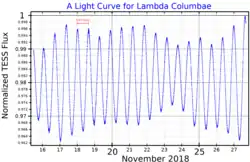| Observation data Epoch J2000.0 Equinox J2000.0 (ICRS) | |
|---|---|
| Constellation | Columba |
| Right ascension | 05h 53m 06.88101s[2] |
| Declination | −33° 48′ 04.9079″[2] |
| Apparent magnitude (V) | 4.86[3] |
| Characteristics | |
| Spectral type | B5 V[4] |
| U−B color index | −0.57[3] |
| B−V color index | −0.15[3] |
| Variable type | Suspected rotating ellipsoidal[5] |
| Astrometry | |
| Radial velocity (Rv) | +30.0[6] km/s |
| Proper motion (μ) | RA: −4.72[2] mas/yr Dec.: +31.32[2] mas/yr |
| Parallax (π) | 9.75 ± 0.21 mas[2] |
| Distance | 335 ± 7 ly (103 ± 2 pc) |
| Absolute magnitude (MV) | −0.17[7] |
| Details | |
| Mass | 4.0±0.1[4] M☉ |
| Radius | 3.4[8] R☉ |
| Luminosity | 213[9] L☉ |
| Surface gravity (log g) | 4.22[10] cgs |
| Temperature | 13,524[9] K |
| Metallicity [Fe/H] | −0.06[10] dex |
| Rotational velocity (v sin i) | 88[11] km/s |
| Age | 56.6±26.1[4] Myr |
| Other designations | |
| Database references | |
| SIMBAD | data |
Lambda Columbae, Latinized from λ Columbae, is a probable binary star[13] in the southern constellation of Columba. With an apparent visual magnitude of 4.86,[3] it is faintly visible to the naked eye. The measured annual parallax shift of 9.75 mas[2] yields an estimated distance of roughly 335 light years.
Lambda Columbae has a stellar classification of B5 V,[4] indicating that it is a B-type main sequence star. It is a suspected rotating ellipsoidal variable[14] with a period of 0.64 days and an amplitude of 0.07 magnitude.[15] Confirmation would indicate that this is a close binary system.[5] It has an estimated age of around 57 million years.[4]
In Chinese, 子 (Zǐ), meaning Son, refers to an asterism consisting of λ Columbae and β Columbae.[16] Consequently, λ Columbae itself is known as 子一 (Zǐ yī, English: the First Star of Son.).[17] From this Chinese name, the name Tsze is derived.[18]
References
- ↑ "MAST: Barbara A. Mikulski Archive for Space Telescopes". Space Telescope Science Institute. Retrieved 31 December 2022.
- 1 2 3 4 5 6 van Leeuwen, F. (2007), "Validation of the new Hipparcos reduction", Astronomy and Astrophysics, 474 (2): 653–664, arXiv:0708.1752, Bibcode:2007A&A...474..653V, doi:10.1051/0004-6361:20078357, S2CID 18759600.
- 1 2 3 4 Mermilliod, J.-C. (1986), "Compilation of Eggen's UBV data, transformed to UBV (unpublished)", SIMBAD, Bibcode:1986EgUBV........0M.
- 1 2 3 4 5 Tetzlaff, N.; et al. (January 2011), "A catalogue of young runaway Hipparcos stars within 3 kpc from the Sun", Monthly Notices of the Royal Astronomical Society, 410 (1): 190–200, arXiv:1007.4883, Bibcode:2011MNRAS.410..190T, doi:10.1111/j.1365-2966.2010.17434.x, S2CID 118629873.
- 1 2 Samus, N.N.; Durlevich, O.V.; et al. (March 2012), General Catalog of Variable Stars, Institute of Astronomy of Russian Academy of Sciences and Sternberg State Astronomical Institute of the Moscow State University.
- ↑ Wilson, R. E. (1953), "General Catalogue of Stellar Radial Velocities", Carnegie Institute Washington D.C. Publication, Carnegie Institute of Washington, D.C., Bibcode:1953GCRV..C......0W.
- ↑ Anderson, E.; Francis, Ch. (2012), "XHIP: An extended hipparcos compilation", Astronomy Letters, 38 (5): 331, arXiv:1108.4971, Bibcode:2012AstL...38..331A, doi:10.1134/S1063773712050015, S2CID 119257644.
- ↑ Pasinetti Fracassini, L. E.; et al. (2001), "Catalogue of Apparent Diameters and Absolute Radii of Stars (CADARS)", Astronomy & Astrophysics (3rd ed.), 367: 521–24, arXiv:astro-ph/0012289, Bibcode:2001A&A...367..521P, doi:10.1051/0004-6361:20000451, S2CID 425754.
- 1 2 McDonald, I.; et al. (2012), "Fundamental Parameters and Infrared Excesses of Hipparcos Stars", Monthly Notices of the Royal Astronomical Society, 427 (1): 343–57, arXiv:1208.2037, Bibcode:2012MNRAS.427..343M, doi:10.1111/j.1365-2966.2012.21873.x, S2CID 118665352.
- 1 2 Hempel, M.; Holweger, H. (September 2003), "Abundance analysis of late B stars. Evidence for diffusion and against weak stellar winds", Astronomy and Astrophysics, 408: 1065–1076, Bibcode:2003A&A...408.1065H, doi:10.1051/0004-6361:20030889.
- ↑ Uesugi, Akira; Fukuda, Ichiro (1970), "Catalogue of rotational velocities of the stars", Contributions from the Institute of Astrophysics and Kwasan Observatory, University of Kyoto, Bibcode:1970crvs.book.....U.
- ↑ "lam Col". SIMBAD. Centre de données astronomiques de Strasbourg. Retrieved 2016-12-26.
{{cite web}}: CS1 maint: postscript (link) - ↑ Eggleton, P. P.; Tokovinin, A. A. (September 2008), "A catalogue of multiplicity among bright stellar systems", Monthly Notices of the Royal Astronomical Society, 389 (2): 869–879, arXiv:0806.2878, Bibcode:2008MNRAS.389..869E, doi:10.1111/j.1365-2966.2008.13596.x, S2CID 14878976.
- ↑ Morris, S. L. (August 1985), "The ellipsoidal variable stars", Astrophysical Journal, Part 1, 295: 143–152, Bibcode:1985ApJ...295..143M, doi:10.1086/163359.
- ↑ Hoffleit, Dorrit (1996), "A Catalogue of Correlations Between Eclipsing Binaries and Other Categories of Double Stars", The Journal of the American Association of Variable Star Observers, 24 (2): 105–116, Bibcode:1996JAVSO..24..105H.
- ↑ (in Chinese) 中國星座神話, written by 陳久金. Published by 台灣書房出版有限公司, 2005, ISBN 978-986-7332-25-7.
- ↑ (in Chinese) AEEA (Activities of Exhibition and Education in Astronomy) 天文教育資訊網 2006 年 7 月 16 日
- ↑ Allen, Richard Hinckley (1963), "Columba Noae, Noah's Dove", Star Names: their Lore and Meaning (Dover ed.).
